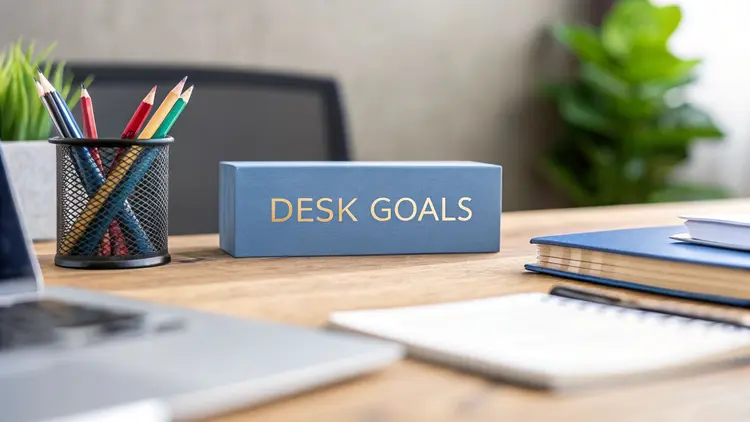A cluttered desk can definitely lead to a cluttered mind. Whether you’re an entrepreneur with ADD, a solo business owner juggling multiple tasks, a content creator battling deadlines, or just anyone trying to boost their productivity, a chaotic workspace can feel overwhelming. Maintaining a well-organized desk isn’t just about aesthetics; it’s a key strategy for success. Think of your desk as your personal command center – optimized for focus and efficiency.
From ancient Zen gardens to the modern Getting Things Done methodology, people have always looked for ways to streamline their environments for better mental clarity. The key to an effective approach? Tailoring it to your specific needs and workflow. A well-organized desk isn’t about spartan emptiness; it’s about intentional arrangement, having what you need at your fingertips, minimizing distractions, and creating a space that inspires.
In this article, we’ll explore 10 game-changing desk organization ideas for different work styles and budgets. Whether you’re seeking stylish storage, innovative tech integrations, or ways to conquer cable chaos, you’ll find practical strategies to transform your workspace from a source of stress to a haven of productivity. Get ready to reclaim your desk, reclaim your focus, and unleash your true potential.
1. Desk Organizer Trays
Drowning in paperwork? Always hunting for that one crucial document? Desk organizer trays can be a lifesaver for entrepreneurs with ADD, solopreneurs, and anyone wanting a productive workspace. These stackable compartments offer a simple way to tame paper clutter and bring order to your desk. They’re essential because they provide a foundation for any organized desk, creating a visual and systematic way to manage paperwork.
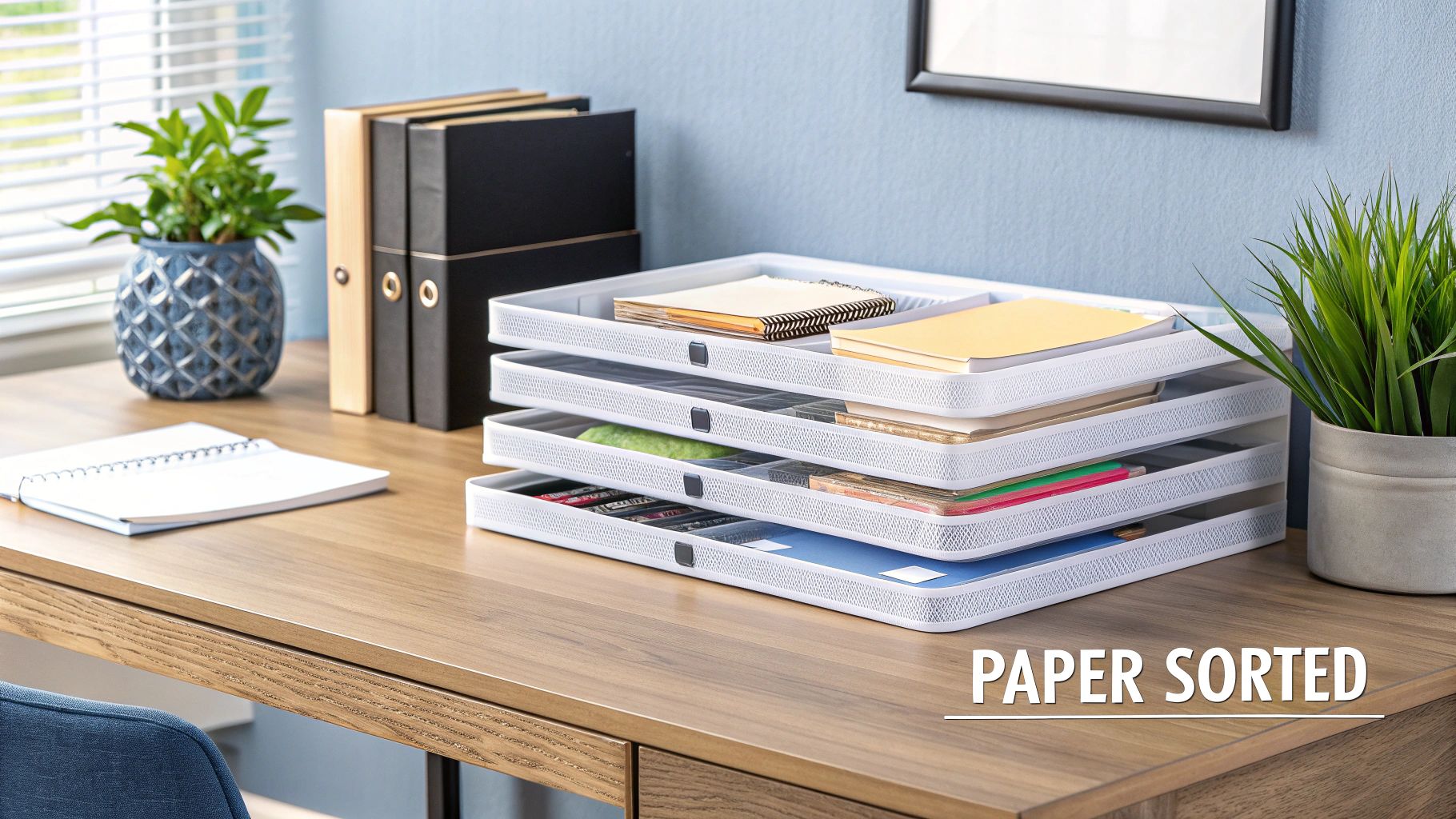
Desk trays categorize documents by priority, type, or status. Think of them as physical inboxes for different tasks. This makes it easy to find the documents you need, when you need them. The stackable design maximizes vertical space, which is great for smaller desks. They come in various materials like plastic, metal, wood, or mesh, so you can pick a style that matches your aesthetic.
Key Features of Desk Trays
- Stackable design: Maximize vertical space.
- Multiple compartments: Sort different document types efficiently.
- Variety of materials: Choose from plastic, metal, wood, or mesh.
Pros and Cons of Using Desk Trays
Let’s look at the advantages and disadvantages of incorporating desk trays into your workspace:
Pros:
- Reduces desktop clutter: Keeps papers organized and off your immediate workspace.
- Visual organization system: See your pending tasks and documents clearly.
- Easily accessible documents: No more searching through piles of paper.
- Customizable arrangement: Adapt the system to your needs.
Cons:
- Space consumption: Multiple trays can take up desk space.
- Potential for clutter: Trays can look messy if papers aren’t sorted.
- Dust accumulation: Papers left untouched can collect dust.
Real-World Examples
Here are a few ways you can utilize desk trays:
- Prioritized Workflow: Trays labeled ‘Urgent’, ‘To Process’, and ‘Completed’ create a clear workflow.
- Project Management: Color-coded trays for different departments or projects keep related documents together.
- Visual Access: Mesh trays let you quickly identify contents.
Evolution and Popularity
Office Depot with its iconic plastic stacking trays, and The Container Store, with its diverse organization solutions, have made desk trays popular. Organization gurus like Marie Kondo also use them, solidifying their place in the organized office.
Tips for Implementation
- Clear Labeling: Label each tray for a functional system.
- Regular Cleaning: Regularly clean out and process papers to maintain efficiency.
- Strategic Placement: Position trays at the side of your desk to maximize your primary working space.
- Visibility: Consider transparent or mesh options for easy viewing.
For more workspace optimization advice, check out: Our guide on Home Office Organization Tips.
By following these simple tips, desk organizer trays can become powerful productivity tools. They can help you stay focused and on top of your tasks. Whether you’re a content creator, a blogger, or just someone looking to conquer paper chaos, desk trays are a worthwhile investment.
2. Monitor Stands With Storage: Reclaim Your Desk and Your Focus
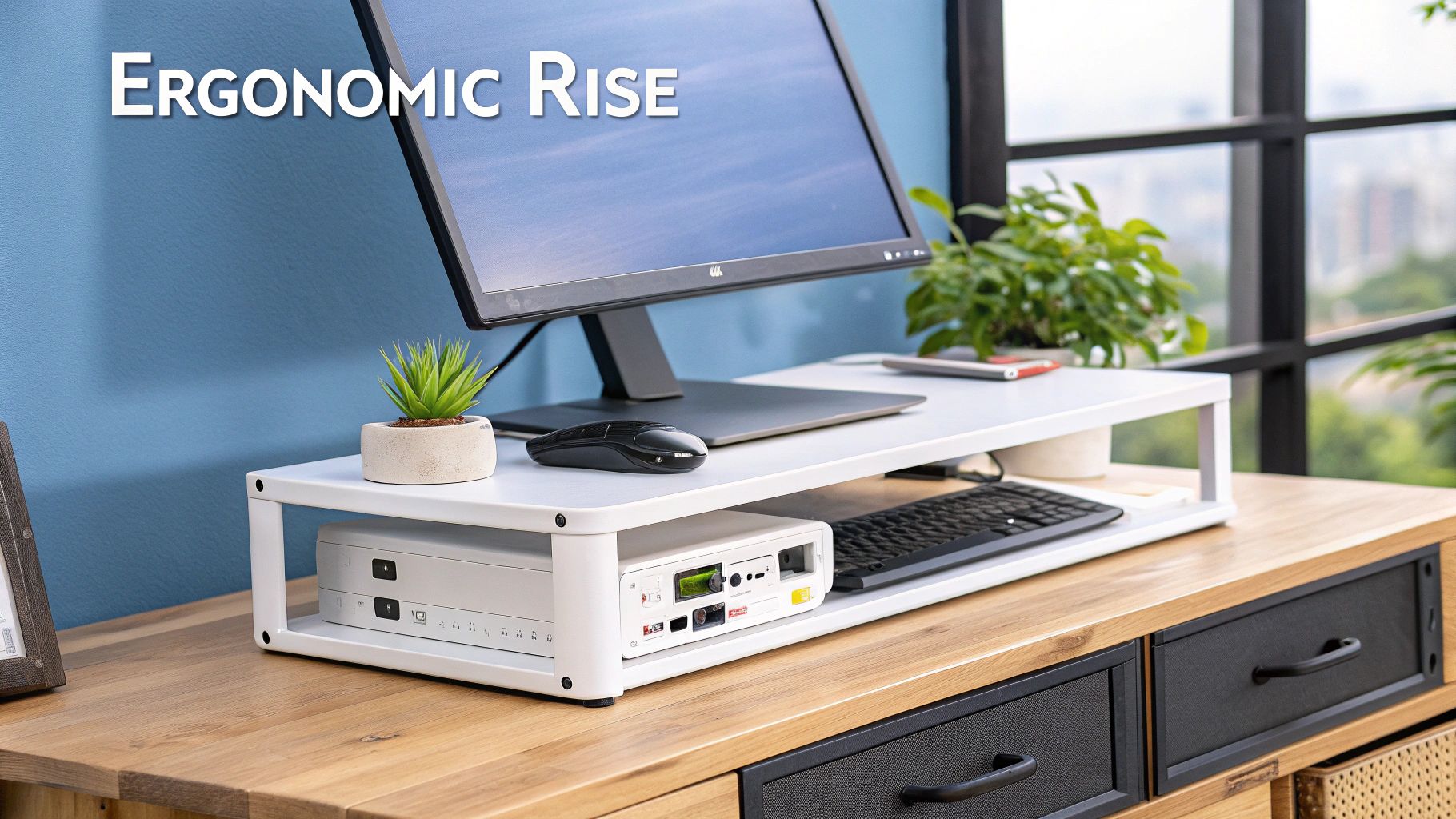
A cluttered desk can feel like a constant battle for entrepreneurs, content creators, and anyone striving for a productive workspace. A monitor stand with storage offers a clever solution. It transforms the often-wasted space beneath your monitor into a hub of organization. This dual-purpose design not only elevates your screen to an ergonomic height but also neatly tucks away clutter. This helps you reclaim valuable desk real estate and maintain focus.
This isn’t just about aesthetics (though a clean desk is visually appealing). It’s about optimizing your workspace for both physical comfort and mental clarity. By combining ergonomic benefits with practical storage, monitor stands address two key elements of a productive work environment.
Elevating Your Workspace – Literally and Figuratively
Monitor stands lift your screen to eye level. This promotes better posture and reduces neck strain – a crucial feature for anyone spending hours in front of a computer. Beneath the stand, a world of storage possibilities opens up. Depending on the model, you might find compartments for notebooks, drawers for pens and paperclips, or open space for external hard drives and other devices.
Features and Benefits:
- Ergonomic Improvement: Say goodbye to neck and backaches by positioning your monitor at the optimal viewing height.
- Space Maximization: Turn unused space into valuable storage, ideal for small desks or minimalist setups.
- Accessibility: Keep frequently used items within arm’s reach, streamlining your workflow.
- Aesthetic Enhancement: A clean, organized desk promotes a sense of calm and control, essential for focus and productivity.
Weighing the Pros and Cons
Pros:
- Improves posture and reduces neck strain
- Creates additional storage without taking up extra desk space
- Keeps frequently used items readily accessible
- Provides a cleaner, more organized look
Cons:
- Limited storage capacity compared to dedicated storage solutions
- Some models may not be height adjustable
- High-quality models can be pricey
- Might not be compatible with all monitor mounting systems
Real-World Examples and Market Evolution
Companies like Grovemade, known for their premium wooden desk accessories, helped popularize the concept of aesthetically pleasing and functional monitor stands. Twelve South’s HiRise adjustable stand brought customizable height adjustment to the forefront, while Satechi integrated tech features like USB-C hubs into their stands. This evolution reflects a growing awareness of the importance of ergonomics and integrated technology in the modern workspace.
Tips for Choosing and Using a Monitor Stand
- Measure Up: Before purchasing, measure your monitor’s dimensions and weight to ensure compatibility.
- Prioritize Your Needs: Consider which items you access most often to determine the ideal storage configuration (drawers, compartments, open space).
- Maximize Organization: Use dividers inside storage compartments to keep things tidy and within easy reach.
- Check Weight Capacity: Make sure the stand can support your monitor and any other items you plan to store.
Examples of Popular Monitor Stands
- Grovemade Wooden Monitor Stand: Renowned for their beautiful and functional wooden desk accessories.
- SONGMICS Bamboo Monitor Stand: A budget-friendly option featuring a sliding drawer.
- Satechi Aluminum Monitor Stand: Offers a sleek, modern design and often includes integrated USB-C hubs.
3. Cable Management Systems
A tangled mess of cables under your desk doesn’t just look bad, it can seriously impact your productivity. Searching for the right cord, accidentally unplugging something, or just feeling overwhelmed by the visual clutter can disrupt your workflow and drain your energy. Cable management systems offer a smart solution, bringing order to the chaos and transforming a jumble of wires into a clean, organized setup. This is especially helpful for entrepreneurs with ADD, solo business owners, and content creators who need a focused and efficient workspace.
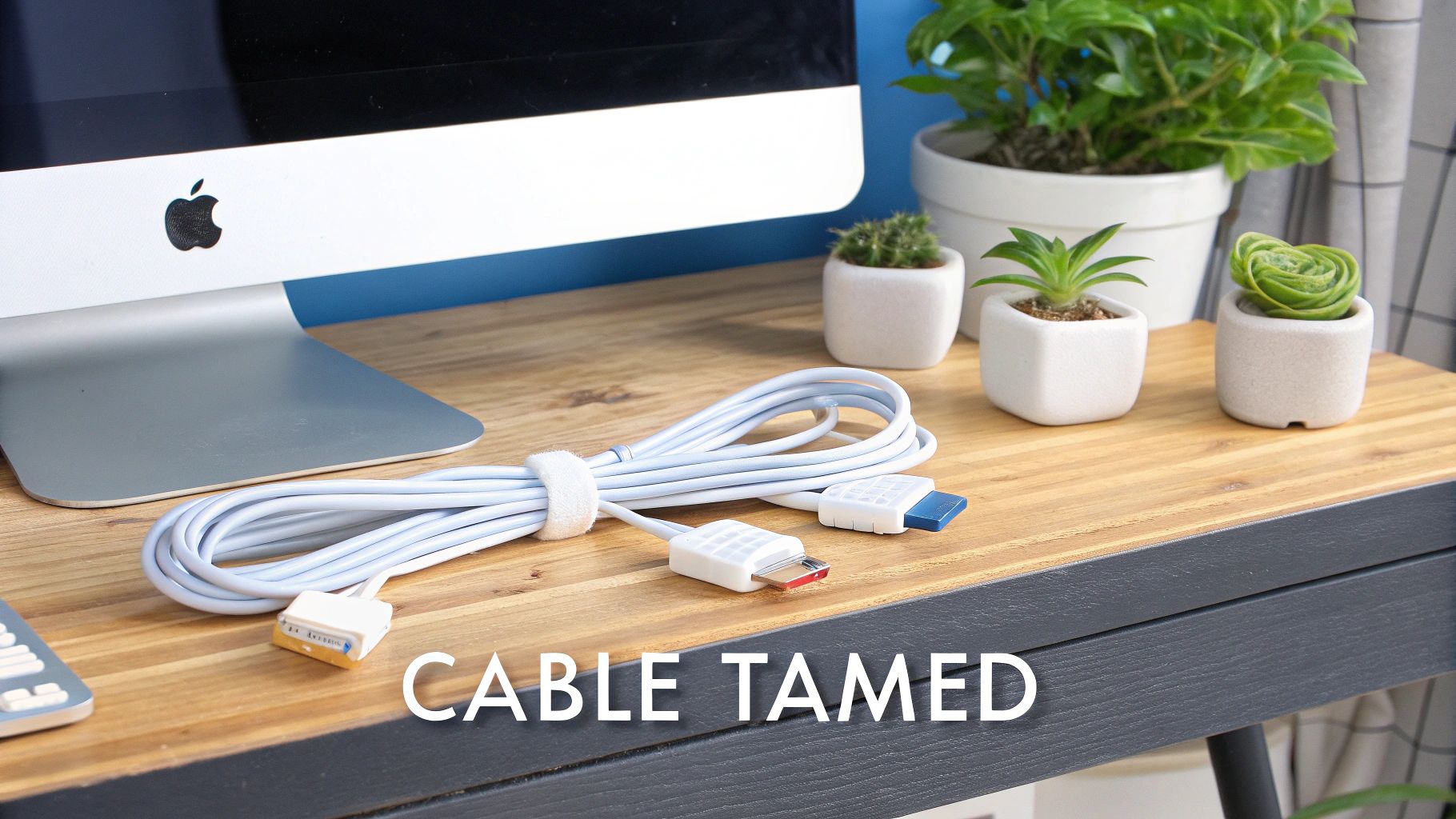
Cable management systems include a wide variety of products designed to both hide and organize cables. There’s a solution for every need and budget, from simple adhesive clips like the Bluelounge CableDrop to under-desk trays like the IKEA Signum cable management rack. You can also use D-Line Cable Management Boxes to conceal power strips and adapters for a more streamlined look. These systems use a range of materials, from plastic and silicone to fabric and metal, offering flexibility and aesthetic choices to match your existing desk setup.
Features and Benefits
Here’s a look at some key advantages of using cable management systems:
- Variety of Solutions: Cable clips, sleeves, boxes, and trays offer specific solutions for different cable types and desk layouts.
- Organization and Concealment: Keep cables neatly bundled and out of sight, minimizing visual clutter and creating a more professional workspace.
- Easy Access: No more fumbling around for the right cable. A well-organized system makes it easy to find and access specific cords when you need them.
- Protection: Cable management systems prevent tangling and reduce the risk of accidental disconnections or damage to your electronics.
- Improved Cleaning: A clutter-free desk is much easier to clean, eliminating dust-collecting wire jungles.
Pros & Cons
Like anything, cable management systems have their upsides and downsides:
- Pros: Reduced visual clutter, prevents tangling, easier cable access, reduced risk of damage, improved cleaning efficiency.
- Cons: Initial setup can be time-consuming, some solutions are difficult to modify, may require desk disassembly, higher-end solutions can be expensive.
Practical Tips for Implementation
Here are a few helpful tips to get you started with cable management:
- Label Your Cables: Use tags to identify each cable’s purpose, saving you time and frustration.
- Group by Function: Bundle cables together based on the device they connect to or their function (e.g., power cables, USB cables).
- Leave Some Slack: Avoid pulling cables taut. Allow a little extra length for device movement and adjustments.
- Temporary Solutions: For quick fixes, use zip ties or Velcro straps to bundle cables together.
- Color-Coding: Consider using different colored cables or cable ties for different devices or functions for even easier identification.
The Rise of Cable Management
Companies like IKEA, with their integrated furniture cable management solutions, and Bluelounge, with their design-focused cable management products, have helped popularize the concept. Also, YouTube tech reviewers showcasing clean and minimalist desk setups have inspired many to tackle their own cable clutter. You might be interested in: 7 Ways to Get Your Brain Into a Productive Rhythm for more tips on creating a productive workspace.
When implementing a cable management system, you’re not just tidying up your desk; you’re creating a more focused, efficient, and ultimately, more productive work environment.
4. Drawer Organizers & Dividers
Let’s be honest, desk drawers can quickly become a black hole of miscellaneous items. For entrepreneurs with ADD, solo business owners juggling multiple tasks, or content creators facing tight deadlines, a messy drawer can seriously impact productivity. That’s where drawer organizers and dividers come in. They transform that chaotic space into a neatly organized home for essential supplies. They deserve a spot on this list because they offer a simple yet powerful solution to a common organizational challenge, directly impacting your efficiency and focus.
These organizers create a personalized storage system within your desk. Instead of a jumbled mess, you have designated compartments for pens, paperclips, sticky notes, charging cables, and other small office supplies. This system lets you quickly find what you need, eliminating frustrating searches that disrupt workflow and concentration, especially valuable for those with ADD. It’s like digital decluttering for your physical workspace, bringing the same order and efficiency to your desk.
These organizers come in various materials, from sleek bamboo and durable plastic to modern metal and soft fabric. You can find expandable organizers with adjustable dividers, modular systems you can customize, and even organizers with built-in phone charging stations – perfect for the tech-savvy entrepreneur or blogger. Clear acrylic organizers let you see everything at a glance, mirroring the visual clarity we strive for in our digital lives. Imagine opening your drawer to see everything neatly arranged and easily accessible – a visual cue for a productive day.
Features and Benefits
- Adjustable/Fixed Compartments: Cater to your specific needs and item sizes.
- Variety of Materials: Choose the aesthetic and functionality that fits your style.
- Modular Designs: Create custom configurations for maximum space efficiency.
- Specialized Organizers: Find options for specific items like electronics or writing utensils.
- Maximizes Drawer Space: No more wasted space or hidden corners.
- Prevents Items from Getting Jumbled: Keeps everything in its place.
- Facilitates Inventory Management: Easily see what you have and what needs restocking.
Pros & Cons
Pros: Increased efficiency, reduced search time, improved organization, designated storage, easier inventory management.
Cons: May not fit all drawers perfectly, custom setups can be pricey, some materials can be tricky to clean.
Real-World Examples
- A content creator could use a bamboo drawer organizer with adjustable dividers to store charging cables, memory cards, and other tech accessories, keeping everything organized and readily available.
- A solo business owner might choose a clear acrylic organizer to quickly find stamps, invoices, and other essential paperwork, minimizing distractions.
Tips for Implementation
- Measure your drawers: Ensure a proper fit before buying.
- Group similar items: Store like with like for easy access.
- Prioritize frequently used items: Place them in the most accessible spots.
- Regularly clean and reassess: Keep your system optimized and clutter-free.
- Consider transparent organizers: For quick visual identification.
Popularity & Evolution
Drawer organization gained traction with the rise of minimalist philosophies and organization gurus like Marie Kondo and her KonMari Method, which emphasizes mindful organization and keeping only items that “spark joy.” Retailers like The Container Store and brands like OXO have further popularized the concept with a wide range of solutions. This reflects a broader cultural shift towards greater efficiency and order in our physical and digital spaces.
By implementing these simple drawer organization strategies, you can transform your desk from a source of stress into a hub of productivity, helping you stay focused, organized, and empowered.
5. Pegboard Wall Organization
Pegboard wall organization is a fantastic way to reclaim desk space and create a workspace that’s both functional and visually appealing. By using the vertical wall space above or near your desk, you transform an often-unused area into a valuable storage hub for your everyday essentials. This is especially helpful for entrepreneurs, solo business owners, content creators, and anyone looking for ways to boost productivity and reduce digital clutter. If you’re striving for a minimalist aesthetic or seeking productivity hacks to improve your work life, pegboard organization is definitely worth exploring.
The heart of this system is a perforated board with evenly spaced holes, designed for a highly customizable arrangement of hooks, shelves, and containers. Pegboards are available in various materials like wood, metal, or plastic. Modern designs offer a stylish look that goes far beyond the traditional workshop pegboard.
For example, the IKEA Skådis pegboard system is a great example of this modern approach, with its sleek design and versatile accessories. Other options, like Block Design’s metal pegboards with colorful accessories, can add a touch of personality to your workspace. You can even opt for custom-built wooden pegboards with matching containers for a truly personalized storage solution.
Adaptability and Accessibility
The real magic of pegboard organization lies in its flexibility. Need to rearrange your workspace? Simply move the hooks and shelves! This adaptability ensures the system can grow and evolve along with your needs. It’s especially useful for keeping frequently used items—like pens, scissors, notepads, and even small tools—visible and within easy reach. This accessibility minimizes distractions and streamlines your workflow, leading to greater productivity. Imagine having your design tools, art supplies, or essential tech gadgets neatly displayed and readily available—no more frantic searching through drawers!
Pros:
- Maximizes Vertical Space: Turns unused wall space into practical storage.
- Enhanced Visibility and Accessibility: Keeps essential items readily available.
- Customizable and Reconfigurable: Adapts to your evolving needs.
- Frees Up Desk Space: Provides a cleaner, more organized work surface.
- Aesthetically Pleasing: Serves as both storage and visual display.
Cons:
- Wall Mounting Required: May not be ideal for renters.
- Dust Exposure: Items on the pegboard can collect dust.
- Potential for Clutter: Requires mindful arrangement to prevent a cluttered look.
- Cost: High-quality pegboard systems can be an investment.
Tips for Implementation:
- Zoning: Organize similar items together in specific areas on the pegboard.
- Breathing Room: Leave some empty space to avoid a cramped look and accommodate future additions.
- Visual Balance: Consider the visual weight and balance of your arrangement.
- Prioritize Placement: Position the most frequently used items at eye level.
- Contain Small Items: Use small containers or trays for tiny items.
The popularity of pegboard wall organization has grown thanks to influences like the IKEA Skådis system, inspiring workspace setups featured on design blogs, Pinterest trends, and crafting communities adapting workshop pegboards for office use. For more workspace design inspiration, check out this helpful resource: Our guide on the Secret of Colors in the Office. By considering these tips and weighing the pros and cons, you can create a highly functional and visually appealing pegboard system that transforms your workspace and boosts your productivity.
6. Desk Accessories With Multi-Functionality
In the quest for a productive and inspiring workspace, multi-functional desk accessories have become real game-changers. These clever tools combine several organizational features into one space-saving unit, offering a streamlined approach to desk management. They’re especially helpful for entrepreneurs with ADD, solo business owners, content creators, and anyone looking for a clutter-free and efficient work area. Instead of a messy pile of individual organizers, multi-functional accessories create a clean, cohesive look while keeping everything you need within easy reach. This resonates with the minimalist philosophy, focusing on essential functions and reducing excess. You might be interested in: Our guide on how to start minimalism.
Imagine a desk lamp with a built-in phone stand, pen holder, and USB charging ports. Or a monitor stand that elevates your screen, offers extra storage underneath, and includes a built-in USB hub. These are perfect examples of how multi-functional design maximizes desk space and minimizes visual clutter. Other popular options include desk organizers with integrated wireless charging and vertical laptop stands with built-in cable management systems, like the Twelve South BookArc.
The advantages are clear: increased functionality in a smaller footprint, fewer individual items cluttering your desk, a more cohesive and aesthetically pleasing workspace, and often a more budget-friendly option compared to buying separate items. This streamlined setup makes it easier to maintain an organized and focused work environment.
Considering the Drawbacks
While multi-functional accessories offer many benefits, it’s important to be aware of potential drawbacks. If one part of a multi-functional item breaks, you might need to replace the whole thing. Also, combining functions can sometimes mean sacrificing some features. A multi-functional desk lamp might not have the same lighting adjustments as a dedicated high-end lamp. Additionally, multi-functional accessories don’t allow for rearranging components individually, and they can sometimes have a higher initial cost than basic single-function items.
Popular Brands and Influencers
Companies like Grovemade, known for their beautiful wooden desk accessories, and Satechi, known for their tech-integrated designs, have made this trend popular. Innovative design-focused brands like Kikkerland have also contributed, along with many minimalist desk setup YouTubers and influencers.
Tips for Choosing Multi-Functional Accessories
To get the most out of multi-functional accessories, keep these tips in mind:
- Prioritize your needs: Select items that combine the functions you use the most.
- Workflow matters: Think about how the item will fit into your daily workflow.
- Measure twice, buy once: Make sure the accessory’s dimensions fit comfortably on your desk.
- Future-proof your setup: Look for modular systems that can adapt to your changing needs.
- Aesthetics are key: Choose designs you find visually appealing, as these items will be a prominent part of your workspace.
By carefully considering these factors, you can use multi-functional desk accessories to create a workspace that is not only organized and efficient but also inspiring and enjoyable.
7. Floating Shelves & Wall-Mounted Storage
Feeling cramped in your home office? Tired of shuffling papers and gadgets around just to find a clear space to work? Floating shelves and wall-mounted storage could be just the solution you’re looking for, especially if you’re an entrepreneur, content creator, or simply someone who thrives in a productive, clutter-free environment. This vertical storage strategy frees up valuable desk space while keeping everything you need within easy reach, transforming a chaotic workspace into a calm and inspiring one.
Instead of piling everything on your desk, imagine a stylish arrangement of shelves and organizers on your walls. Books, supplies, plants, and even decorative items can find a home, creating a personalized and visually appealing workspace. This isn’t just about aesthetics; it’s a practical way to improve your workflow and minimize distractions.
Why It Works
Floating shelves and wall-mounted solutions maximize vertical space, a resource that is often underutilized, particularly in smaller home offices. This three-dimensional approach expands your storage capacity without taking up any floor or desk space. Keeping items visible on open shelves also makes them easily accessible; no more rummaging through drawers! You can even arrange items based on how often you use them, creating a customized organization system that fits your specific work style.
Features & Benefits
- Space-Saving Design: Because they’re wall-mounted, these solutions don’t require any floor or desk space.
- Variety: You’ll find a wide range of depths, lengths, and materials (wood, metal, plastic) to suit different needs and aesthetics. Options include simple shelves, cubbies, specialized organizers, and even designs incorporating hooks or cable management systems.
- Visual Appeal: Floating shelves not only provide storage but also serve as a way to personalize your space. Display inspiring objects and create a visually stimulating work environment.
- Accessibility: Items are readily visible and accessible, which is a huge plus for anyone easily distracted.
Pros & Cons
Pros:
- Maximizes vertical space
- Keeps desk surface clear
- Creates visual interest and personalization opportunities
- Easy access to frequently used items
- Customizable to individual workflows
Cons:
- Requires wall mounting (may not be suitable for all renters)
- Limited weight capacity compared to other storage solutions
- Items are exposed to dust
- Installation requires tools and some DIY know-how
- Can look cluttered if not styled carefully
Real-World Examples & Case Studies
- IKEA Eket Wall-Mounted Cabinet Series: Offers a modular and affordable way to create customized wall storage.
- Umbra Cubist Floating Shelves: A stylish and modern option with multiple compartments for organizing various items.
- Custom-built Wooden Floating Shelves with Integrated Lighting: Adds a touch of sophistication and functionality.
- Wall-Mounted File Organizers: Keeps important documents for current projects readily accessible and organized.
Tips for Implementation
- Strategic Placement: Install shelves at a comfortable height so you can easily reach frequently used items.
- Prioritize Visibility: Use shelf space for items you access regularly but don’t need constantly on your desk.
- Balance & Aesthetics: Combine open shelving with closed storage (cabinets or decorative boxes) for a balanced, less cluttered look.
- Secure Installation: Ensure proper wall anchoring to support the weight of your items.
- Cohesive Design: Coordinate shelf materials and colors with your desk and overall office décor.
Rise in Popularity
Floating shelves and wall-mounted storage have become incredibly popular in recent years, thanks to a few key factors:
- IKEA’s Influence: IKEA’s wide selection of affordable and stylish wall storage solutions has made the concept more accessible.
- Pinterest & Design Blogs: Pinterest and minimalist design blogs offer endless inspiration for incorporating floating shelves into a workspace.
- Small Space Living: People living in studio apartments or smaller homes have embraced wall-mounted storage as a practical necessity.
By embracing vertical storage with floating shelves and wall-mounted organizers, you can transform your workspace into a hub of productivity and creativity. So, say goodbye to desk clutter and hello to a more organized and inspiring work environment!
8. Rotating Desktop Organizers
Ever find yourself playing a constant game of reach-and-retrieve across your desk? Rummaging through drawers, shuffling papers, and generally feeling like your workspace is a chaotic black hole of productivity? For entrepreneurs with ADD, solopreneurs juggling multiple tasks, and anyone striving for a more organized and efficient workflow, this struggle is real. Thankfully, the ingenious rotating desktop organizer is here to save the day! These spinning wonders, also known as carousel organizers, are a fantastic way to maximize desk space while keeping essential supplies at your fingertips.
These organizers typically feature a rotating base with multiple compartments, perfect for holding pens, pencils, highlighters, scissors, sticky notes, and other frequently used items. The 360-degree rotation allows you to quickly grab anything you need without stretching or rearranging your entire desk. This simple mechanism can significantly reduce clutter and improve your workflow, especially valuable in smaller workspaces or shared desk arrangements. Think of it like a classroom-style rotating supply caddy, reimagined for the modern workspace.
Why a Rotating Organizer Deserves a Spot on Your Desk
- Accessibility is King: Say goodbye to digging through drawers or reaching across a cluttered desk. Everything you need is a simple spin away. This can be especially helpful for those with ADD who benefit from visual cues and easy access to tools.
- Compact Footprint: Rotating organizers make the most of vertical space, providing ample storage without taking over your entire desk. This is a huge plus for smaller desks, corner desk setups, or anyone embracing a minimalist aesthetic.
- Organized Zones: Designate separate compartments for different types of supplies, creating distinct zones for writing utensils, paper clips, and other essentials. This visual organization can boost productivity and reduce the mental clutter that comes with a disorganized workspace.
- Variety of Styles: From sleek, modern acrylic designs to industrial metal mesh options, there’s a rotating organizer to match any workspace aesthetic. You can even find multi-tiered organizers with specialized compartments for more complex organizational needs.
Pros & Cons
- Pros: Provides easy access to numerous supplies in a compact footprint, eliminates reaching, keeps supplies visible and accessible, works well in corners, creates organized zones.
- Cons: Limited capacity for larger items, can look cluttered if overfilled, less customizable than modular systems, rotation mechanism may wear out over time.
Tips for Maximizing Your Rotating Organizer
- Strategic Placement: Position your organizer in a corner or at the side of your desk for easy access without it dominating your workspace.
- Grouping Similar Items: Store like items together in adjacent compartments for intuitive organization.
- Avoid Overfilling: Resist the urge to cram too much into each compartment. A cleaner, less cluttered look promotes a more productive workspace.
- Transparency is Key: Opt for transparent or mesh organizers so you can easily see all the contents.
- Regular Decluttering: Periodically rotate the carousel and remove any unused items to maintain an efficient and clutter-free workspace.
From Classroom to Creative Workspace
Rotating organizers, initially popularized by office supply retailers like Staples and Office Depot, have seen a resurgence in popularity. They’re a favorite among content creators, bloggers, and those seeking analog organizational solutions in an increasingly digital world. Art supply companies have also embraced the concept for creative workspaces, and university bookstores often stock them for student desk organization. This widespread adoption speaks volumes about the versatility and effectiveness of this simple yet powerful organizational tool.
While there’s no single magic solution for maximizing productivity, a rotating desktop organizer can be a significant step toward a more organized and efficient workspace. By minimizing clutter and maximizing accessibility, these spinning companions can help you focus on what truly matters – your work.
9. Under-Desk Storage Solutions
Want to reclaim some valuable real estate in your workspace? Especially if you’re a busy entrepreneur or content creator juggling multiple projects, optimizing the space under your desk can be a game-changer. It’s often an overlooked area ripe for transformation into an organized hub.
Under-desk storage solutions offer a clever way to utilize this often-wasted zone. Think everything from simple mountable drawers and trays to rolling cabinets and even hanging baskets. You’ll keep essential items within easy reach while maintaining a clean and clutter-free desk surface.
Exploring Different Options
The beauty of under-desk storage lies in its versatility. You can find options that mount directly to the underside of your desk using clamps, adhesives, or screws. Or, if you prefer, choose freestanding units that simply sit on the floor. This flexibility makes it adaptable to various desk types and even works great in rental situations where permanent modifications aren’t allowed. Materials also vary widely, from sturdy metal and wood to lightweight plastic and fabric, so you can find something that suits your aesthetic and storage needs.
Clever Storage Ideas
Imagine taming that tangled mess of wires with under-desk cable management trays and power strip mounts. A pull-out keyboard tray can double as shallow storage for notebooks and pens. Hanging fabric baskets are perfect for lightweight items like headphones or charging cables. And for more substantial storage, clamp-on drawer units offer a convenient home for all those essential office supplies.
Why Under-Desk Storage is Trending
The rise in popularity of under-desk storage isn’t a surprise. Ergonomic workspace designers have long emphasized the importance of a clean and organized work environment for optimal productivity. Companies like 3M with their innovative mounting solutions, and IKEA with their desk systems featuring under-mount accessories, have also played a role in bringing these solutions to the mainstream. The growing trend of minimalist office design has further fueled the adoption of under-desk storage, helping conceal clutter and create a more visually appealing workspace.
Weighing the Pros and Cons
Pros:
- Utilizes unused space beneath the desk
- Keeps desk surface clear
- Hides clutter
- Doesn’t take up additional floor or wall space
- Offers non-permanent options, ideal for rentals
Cons:
- Limited access compared to desktop storage
- May reduce leg room
- Installation can be challenging for some desks
- Some options require drilling
Tips for Implementation
- Measure: Carefully measure the space under your desk before buying anything.
- Movement: Think about your leg movement to avoid obstructions.
- Prioritize: Store less frequently used items further back.
- Non-Permanent Options: Consider adhesive or clamp solutions for easy removal.
- Easy Access: Pull-out or sliding mechanisms can make access easier.
Looking for more organization tips? Check out our guide on decluttering your bedroom for inspiration.
Under-desk storage is a must-have for any organized workspace. It’s a practical and efficient way to maximize your space and create a cleaner, more productive work environment. This is especially valuable for entrepreneurs, content creators, or anyone striving for a clutter-free and focused workspace.
10. Digital Organization & Paperless Systems
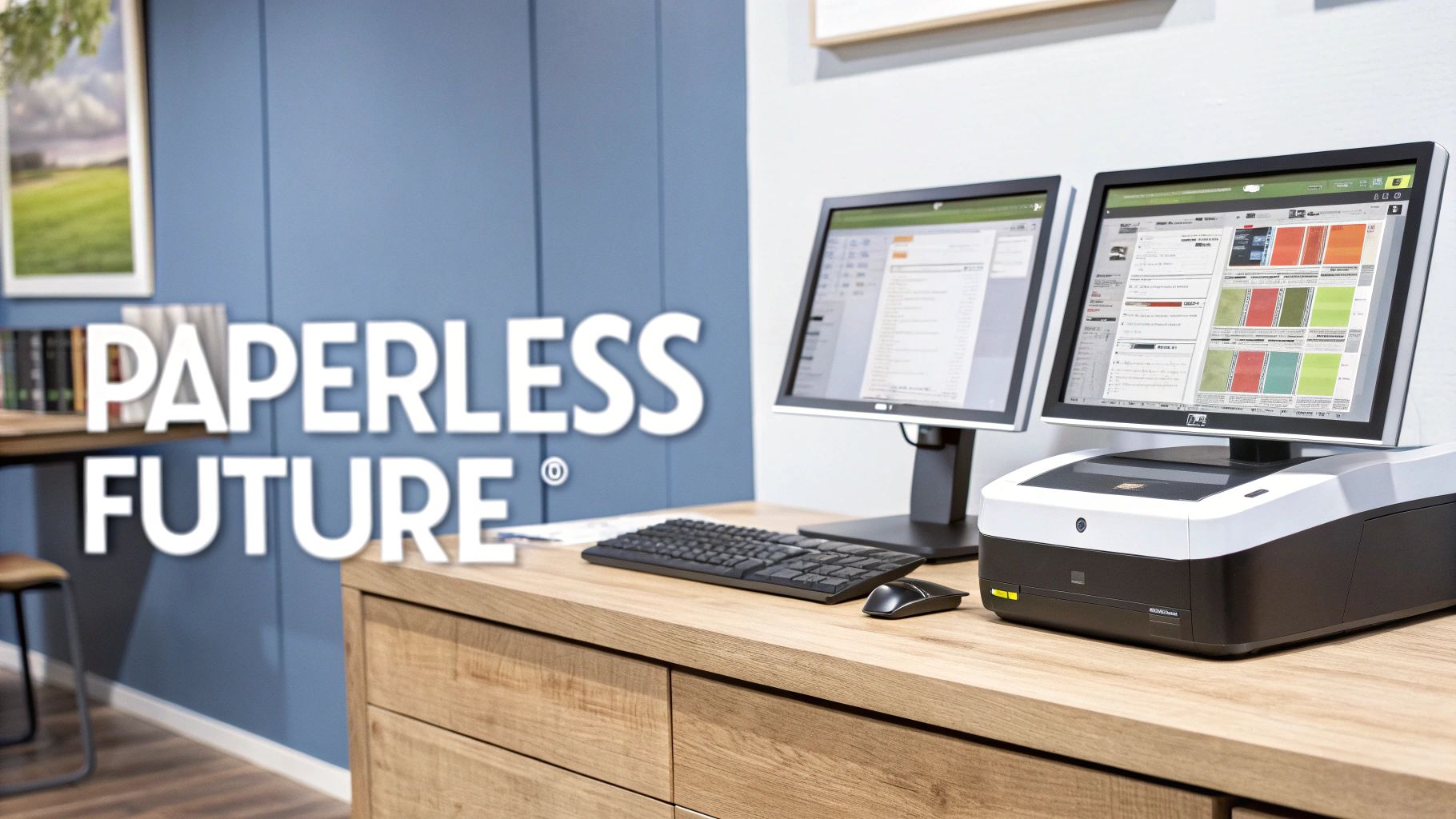
For entrepreneurs with ADD, solopreneurs juggling multiple projects, or content creators overflowing with ideas, a cluttered desk can seriously hinder productivity. That’s where the magic of digital organization and paperless systems comes in. Imagine a workspace where the only physical paper is the notebook you’re actively using. Everything else? Neatly organized in your digital world.
Digital organization goes beyond simply scanning documents. It’s about building an efficient workflow. This way, your information is easily accessible, searchable, and ready to share. It streamlines your processes, freeing you to focus on what truly matters.
Features and Benefits
Think of it as building a “second brain” for your business. Here’s how key features make this possible:
- Document Scanning and OCR: Transform paper documents into searchable digital text using Optical Character Recognition (OCR). This is a game-changer for archiving receipts, contracts, and notes.
- Cloud Storage and File Management: Services like Google Drive and Dropbox offer accessible storage and version control. Free up physical space and collaborate with ease.
- Digital Note-Taking: Apps like Evernote, Microsoft OneNote, and Notion offer robust platforms for organizing thoughts, project details, and research. Handwriting recognition adds even more flexibility.
- Electronic Signatures and Forms: Say goodbye to printing, signing, and scanning. Electronic solutions speed up workflows and reduce paper waste.
- Digital Calendars and Task Management: Keep track of appointments and deadlines digitally, integrating seamlessly with your other digital tools.
Pros of Going Paperless
- Reduced Clutter: A clear desk often leads to a clear mind. Less paper clutter means less visual distraction.
- Improved Search: No more endless searching through piles of paper. Find what you need instantly.
- Remote Access: Work from anywhere with an internet connection. Access your files anytime, anywhere.
- Easy Sharing: Share files and projects instantly with colleagues or clients. Collaboration becomes effortless.
- Eco-Friendly: Reduce your paper footprint and contribute to a greener environment.
- Enhanced Security: Control access and protect sensitive information with digital security measures.
Cons of Going Paperless
- Initial Time Investment: Setting up a digital system and scanning existing documents takes time and effort.
- Learning Curve: Getting comfortable with new software can require a bit of a learning curve.
- Tech Dependence: You’ll need reliable access to your digital devices and the internet.
- Security Risks: Strong passwords and two-factor authentication are crucial to protect your data.
- Physical Copies: Some documents may still require physical copies for legal or regulatory reasons.
Real-World Examples and Evolution
The rise of digital organization has been influenced by productivity methods like David Allen’s Getting Things Done (GTD) and Tiago Forte’s Building a Second Brain. Tools like Evernote and Microsoft OneNote were pioneers in the field, paving the way for platforms like Notion. Even Marie Kondo’s minimalism philosophy has found its way into the digital world.
For example, a blogger could use Evernote to save articles, organize blog post drafts, and store images. A solo business owner might use Google Drive to manage client files, collaborate on projects, and access invoices remotely.
Practical Tips for Implementation
- File Naming: Create a consistent file naming system for easy searching.
- Regular Scanning: Schedule regular scanning sessions to prevent paper from piling up again.
- Quality Scanner: Invest in a high-quality scanner for important documents.
- Folder Structure: Use a clear folder structure that makes sense for your workflow.
- Backups: Regularly back up your digital files in multiple locations for data security.
- Dual Monitors: Consider using dual monitors to reduce the need for printed reference materials.
By going digital, you’re not just tidying your desk. You’re creating a more efficient, productive, and adaptable workspace. This can be a real game-changer for anyone looking to boost productivity and reduce stress.
10 Desk Organization Ideas: Side-by-Side Comparison
| Item | Complexity (🔄) | Resources (⚡) | Expected Outcomes (📊) | Ideal Use Cases (💡) | Key Advantages (⭐) |
|---|---|---|---|---|---|
| Desk Organizer Trays | Low | Minimal | Neat paper sorting | Offices with heavy paper usage | Customizable and easily accessible |
| Monitor Stands with Storage | Moderate | Moderate | Ergonomic improvement with added storage | Computer workspaces needing posture support | Dual-purpose design that declutters |
| Cable Management Systems | Moderate | Low | Tidier cables and reduced visual clutter | Tech-heavy desks; setups with many cords | Prevents tangling and enhances safety |
| Drawer Organizers & Dividers | Low | Minimal | Well-compartmentalized supplies | Drawers with small items and frequent misplacement | Efficient, simple, and time-saving |
| Pegboard Wall Organization | High | Moderate-High | Expanded vertical storage and visible access | Offices with available wall space | Highly customizable with an aesthetic touch |
| Desk Accessories with Multi-Functionality | Moderate | Moderate | Cohesive, space-saving desk arrangement | Minimalist or compact desk environments | Combines functions and reduces clutter |
| Floating Shelves & Wall-Mounted Storage | High | Moderate-High | Clear desk surface with additional visible storage | Creative workspaces or offices seeking decor balance | Maximizes vertical space and style |
| Rotating Desktop Organizers | Low | Minimal | Compact, 360° easy-access storage | Small desks or shared workspaces | Provides fast, all-around access |
| Under-Desk Storage Solutions | Moderate | Low-Moderate | Utilizes wasted space to declutter the desktop | Offices needing hidden, extra storage | Discreet use of underutilized space |
| Digital Organization & Paperless Systems | High | Moderate-High | Drastic reduction of physical clutter | Digital-centric workflows and remote work settings | Eco-friendly and efficient document management |
Design Your Ideal Workspace for Peak Performance
From decluttering your digital files to optimizing your physical desktop with trays, stands, and clever storage solutions, the ideas we’ve explored offer a powerful toolkit for transforming your workspace. Remember, the key principles are functionality, personalization, and adaptability. What works for a minimalist content creator might not be ideal for an entrepreneur juggling multiple projects.
Experiment with different combinations of the organization tools mentioned:
- Drawer dividers
- Pegboards
- Floating shelves
- Under-desk storage
- Rotating organizers
This will help you discover what best suits your individual needs and work style.
As you implement these changes, think about your workflow. Where do bottlenecks occur? Which tasks require the most focus? Design your space to support these critical activities.
For example, if cable clutter constantly disrupts your flow, invest in a robust cable management system. If you’re constantly searching for misplaced documents, a digital organization system might be your game-changer. Embrace the process of learning and adapting, tweaking your setup as your needs evolve.
Looking Ahead: The Future of Workspace Organization
Looking ahead, the trend towards integrated digital and physical organization systems will continue to gain momentum. Expect to see more smart desk accessories and personalized productivity solutions emerge. Staying informed about these developments can help you maintain a workspace designed for peak performance.
Key Takeaways for an Organized and Productive Workspace
- Declutter Regularly: A tidy workspace fosters a clear mind.
- Prioritize Functionality: Choose tools that support your workflow.
- Personalize Your Approach: There’s no one-size-fits-all solution.
- Embrace Adaptability: Your organizational needs will change over time.
- Integrate Digital and Physical Systems: Streamline your entire workflow.
Feeling Overwhelmed? You’re Not Alone!
Feeling overwhelmed by the thought of implementing all these changes, especially if you’re juggling the demands of entrepreneurship and perhaps managing ADD? You’re not alone. Lorelei Web is a content-rich platform designed specifically to empower entrepreneurs like you.
Get actionable advice on everything from journaling and mind mapping to conquering digital clutter and maximizing WordPress for your business. Lorelei shares her personal experiences and proven strategies for cutting through the noise and focusing on what truly matters. Start streamlining your business and reclaiming your mental clarity today. Visit Lorelei Web and discover the power of organized productivity.

Lorelei has been an online entrepreneur, marketer and writer since 2006. Her biggest passion is WordPress, which is why she switched to being a full-time blogger 20 years ago and hasn’t looked back since. With so many years of experience behind her, she is an expert in copywriting, SEO, marketing and business strategies.






